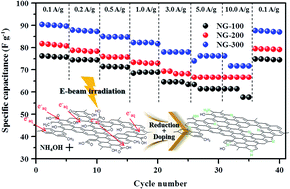Nitrogen-doped graphenes (NGs) were successfully obtained by electron beam (e-beam) irradiation from graphite oxide (GO) colloid solution in the presence of aqueous ammonia at room temperature under ambient conditions. The morphology, structure, and components of the obtained NGs were characterized by scanning electron microscopy, Raman spectroscopy, powder X-ray diffraction, elemental analysis, and X-ray photoelectron spectroscopy. The amount of incorporated nitrogen was in the range ∼3.20–3.54 wt% with pyrrolic-N as the main nitrogen configuration. The results of this study show that nitrogen was simultaneously doped into graphene as the GO was reduced by e-beam irradiation. Herein, the ratio of nitrogen sites (pyridinic-N, pyrrolic-N, graphitic-N, and pyridinic-N-oxide) and specific surface area were controlled for various applications of the NGs as a function of irradiation dose. Increasing concentrations of graphitic-N and pyridinic-N-oxide enhanced the electrical conductivity and improved the kinetic performance of supercapacitor. The highest capacitance of 90.5 F g−1 at a charge/discharge current of 0.1 A g−1 in organic media was achieved for NG-300 because of a high BET specific surface area of 470 m2 g−1.
